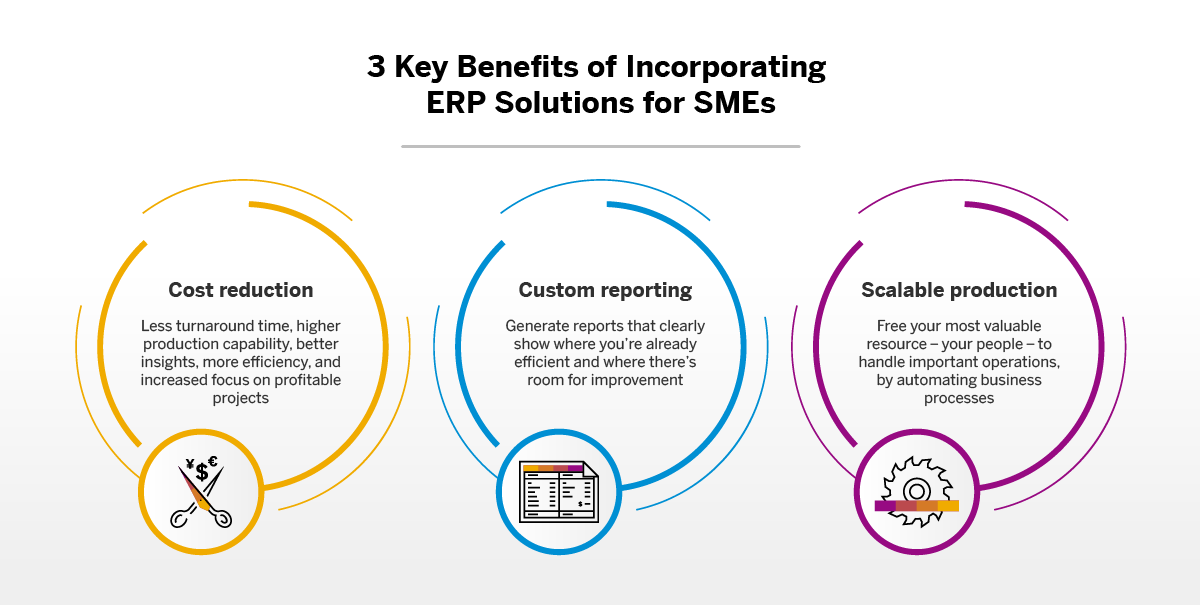Enterprise resource planning (ERP) is a modular software system that is scalable and flexible that gives enterprises access to a system of highly integrated applications. It allows businesses to focus on what is essential to their success. The ERP system for SMEs has a direct impact on cost savings and operational improvements. This helps businesses survive and prosper in difficult economic situations.
Small businesses are now moving from paper-based systems and Excel spreadsheets to modern ERP automation, including digital scheduling and analysis of production tools. It has been observed that the development and emergence of several ERP software programs over the last decade has made business operations easier. As per a report by Allied Research, the ERP market is expected to grow at a CAGR of 9.8% from 2020 to 2027 to reach $86 Billion by 2027. The bulk of the growth is expected from ERP systems from SMEs.

Inventory Management, Invoice Tracking, Market Research, Accounting, Capacity Planning, Quality Control, etc., are a part of an integrated system that can be shared and managed through a centralized database to streamline business operations. With the help of a Cloud ERP suite, manufacturers can turn their daily data into actionable business intelligence and automate processes on the cloud.
Key benefits of incorporating ERP solutions for SMEs
The ERP software allows enterprises to condense workflows, streamline processes, and automate, eliminating the need for manual input. ERP system from SMEs is benefiting the SMEs through –
- Cost Reduction: When employees have fewer manual processes to weigh them down, they’ll be free to take on more innovative, profitable projects. Ease of workflow increases, with less turnaround time and high production capability.
ERP is a solution that provides transparency about how problems affect the rest of the process, allowing managers to analyze, gain better insights, and make effective decisions. It provides real-time financial data that offers a competitive advantage, increases efficiency, and helps ensure cost savings.
- Custom Reporting: Organizations rely on reporting to track KPIs across every department. If one department or functionality falls behind, it can affect all the other departments. However, you can’t produce useful reports without a proper system. An effective ERP solution generates reports that clearly show where you’re already efficient and where there’s room for improvement.
- Scalable Production: ERP brings a game-changing level of scalability to business processes. The automation of operations takes the burden off employees and guarantees a solid record of workflow. That frees your most valuable resource – your people – to handle the other important operations. A cloud ERP suite can be used to scale the business processes easily by automation of businesses processes on the cloud.

Successful ERP implementation case studies
Talking Rain is a beverage company in Washington State. Before adopting the ERP system, they wasted a lot of time via manual processes. To assign a customer’s purchase to the corresponding account, employees had to manually populate the table with data from individual tables for further analysis. To perform historical analysis, employees must re-enter the information from the system into the table and compare it to the same data for the year. Extracting data for a month’s corporate transactions can take up to 15 minutes. This led to a loss of productivity.
To improve their productivity level, they installed a new ERP solution, so all company information was now stored in one system, not in myriad spreadsheets. This solution is used for accounts payable and accounts receivable, financial reporting, and production planning and scheduling. This includes processing the entire inventory turnover, from the start of job orders to the planning, consumption, and shipping of these orders.
They can now run ad hoc reports and queries in minutes instead of days. It reduced the risk of out-of-stock, late delivery, and lost invoices and orders, significantly improving customer experience. Sales have also grown by double digits; the new system has certainly given the company a competitive advantage.
MacKay & Sposito, a civil engineering consultancy, was facing difficulty measuring which projects and segments were the most profitable. They decided to implement a new ERP system which increased the cash flow and profitability between jobs by connecting the entire company, including projects, finance, and material management.
They are now able to track sector-level performance and adjust the budget in order to manage project costs and maximize resource utilization. The ERP system measures performance against set goals and provides executives with the reports they need to focus their business development efforts on.
The company reduced its monthly closing from 5 days to 2 days and now pays twice a month in just 2 hours. In addition, easy access to historical data makes bid estimates more accurate, attracting more profitable contracts.
Western Digital is a technology company offering products in the areas of data storage, data systems and data solutions. The merger of Western Digital, SanDisk and HGST in 2019 was a major challenge for the company. Western Digital aimed to centralize its ERP system so that all the three companies could be managed together. The company chose an ERP software which led to the integration of the business units in the areas of Information technology, HRM, Payroll, Customer relationship analysis, etc.
Drawbacks of ERP system
To get the maximum benefit from an ERP system, there are some challenges that enterprises must overcome.
Cost: The main deterrent to ERP is the cost of pre-integration and ongoing subscriptions and licenses related to technology. Depending on the size of your company, purchasing, implementing, and maintaining your ERP system can be expensive. On-premises systems also require enterprises to consider infrastructure costs such as IT support and server hardware. As your organization grows and operational needs grow, companies may need to purchase additional supplementary services or software.
Implementation Challenges: Even with the complete implementation checklist, running an ERP system requires time, money, and resources. Organizations need to allocate internal staff resources to determine which ERP system to purchase. This can be a detailed process involving managers of finance, operations, IT, and in some cases, sales, marketing, and human resources. For companies with diverse spreadsheets and stacks of paper files, there may be a long data migration process that may require the hiring of an integrated specialist.
Conclusion
The need for a cheap, well-designed ERP system for small businesses is recognized in the current competitive organization culture. Small businesses require ERP systems to perform fast-paced and complex manufacturing processes. SMEs must carefully assess their requirements and select the software they want to use to enjoy the maximum benefits such as reduced costs, operational planning, CRM, etc.



